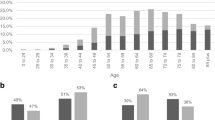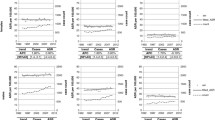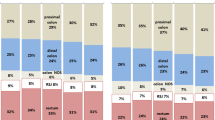Abstract
Background
While overall colorectal cancer (CRC) rates in the USA are declining, the incidence of early-onset CRC (eoCRC) under age 50 is increasing. The aim of this study was to examine the risk of a second primary malignancy (SPM) in individuals with eoCRC, and how this risk compares to those with late-onset CRC (loCRC).
Methods
We used data from the Surveillance, Epidemiology, and End Results Program database to examine the risk of SPM after a diagnosis of eoCRC. Standardized incidence ratios (SIR) were used to estimate the risk of SPM after eoCRC and loCRC in comparison with the risk of malignancy in the general population.
Results
Compared to the general population, individuals with eoCRC, but not loCRC, had an increased lifetime risk of SPM (SIR 1.42, 95% CI 1.37–1.48 and SIR 1.00, 95% CI 0.99–1.02, respectively), and locations at highest risk were the small intestine, ureter, rectum, and colon. The risk of SPM after eoCRC was similar in men and women, but higher in non-whites compared to whites and higher in those with a lower area-level median household income. The risk of SPM following eoCRC was high in the first 5 years after diagnosis (SIR 2.44, 95% CI 2.24–2.66) and, in a birth cohort analysis, was found to be increasing over time.
Conclusions
Individuals with eoCRC have a lifetime risk of SPM nearly 50% higher than the general population. The risk of SPM is highest in the first 5 years after diagnosis and is increasing over time.




Similar content being viewed by others
References
Siegel RL, Jemal A, Ward EM. Increase in incidence of colorectal cancer among young men and women in the United States. Cancer Epidemiol Biomark Prev. 2009;18:1695–1698. https://doi.org/10.1158/1055-9965.Epi-09-0186.
Siegel RL, Fedewa SA, Anderson WF et al. Colorectal cancer incidence patterns in the United States, 1974–2013. J Natl Cancer Inst. 2017;109:djw322. https://doi.org/10.1093/jnci/djw322.
Bailey CE, Hu C-Y, You YN et al. Increasing disparities in the age-related incidences of colon and rectal cancers in the United States, 1975–2010. JAMA Surg. 2015;150:17–22. https://doi.org/10.1001/jamasurg.2014.1756.
Surveillance, Epidemiology, and End Results (SEER) Program (www.seer.cancer.gov) SEER*Stat Database: Incidence—SEER Research Data, 9 Registrties, Nov 2019 Sub (1975–2017)—Linked to County Attributes—Time Dependent (1990–2017) Income/Rurality, 1969–2017 Counties, National Cancer Institute, DCCPS, Surveillance Research Program, released Apreil 2020, based on the November 2019 submission.
Surveillance Research Program. National Cancer Institute SEER*Stat software (seer.cancer.gov/seerstat) version 8.3.8.
Yang J, Li S, Lv M et al. Risk of subsequent primary malignancies among patients with prior colorectal cancer: a population-based cohort study. Onco Targets Ther. 2017;10:1535–1548. https://doi.org/10.2147/OTT.S129220.
Guan X, Jin Y, Chen Y et al. The incidence characteristics of second primary malignancy after diagnosis of primary colon and rectal cancer: a population based study. PLoS ONE. 2015;10:e0143067. https://doi.org/10.1371/journal.pone.0143067.
Hemminki K, Li X, Dong C. Second primary cancers after sporadic and familial colorectal cancer. Cancer Epidemiol Biomark Prev 2001;10:793–798.
Liang Y-H, Shao Y-Y, Chen H-M et al. Young patients with colorectal cancer have increased risk of second primary cancers. Jpn J Clin Oncol. 2015;45:1029–1035. https://doi.org/10.1093/jjco/hyv137.
Donin N, Filson C, Drakaki A et al. Risk of second primary malignancies among cancer survivors in the United States, 1992 through 2008. Cancer. 2016;122:3075–3086. https://doi.org/10.1002/cncr.30164.
He X, Wu W, Ye Ding, Li Y, Si J, Sun L. Excessive risk of second primary cancers in young-onset colorectal cancer survivors. Cancer Med. 2018;2018:1201–1210. https://doi.org/10.1002/cam4.1437.
Boardman LA, Johnson RA, Petersen GM et al. Higher frequency of diploidy in young-onset microsatellite-stable colorectal cancer. Clin Cancer Res 2007;13:2323–2328. https://doi.org/10.1158/1078-0432.Ccr-06-2739.
Antelo M, Balaguer F, Shia J et al. A High Degree of LINE-1 hypomethylation is a unique feature of early-onset colorectal cancer. PLoS ONE. 2012;7:e45357. https://doi.org/10.1371/journal.pone.0045357.
Dwyer AJ, Murphy CC, Boland CR et al. A summary of the fight colorectal cancer working meeting: exploring risk factors and etiology of sporadic early-age onset colorectal cancer. Gastroenterology. 2019;157:280–288. https://doi.org/10.1053/j.gastro.2019.04.049.
Ballester V, Rashtak S, Boardman L. Clinical and molecular features of young-onset colorectal cancer. World J Gastroenterol. 2016;22:1736–1744. https://doi.org/10.3748/wjg.v22.i5.1736.
Hughes LAE, Melotte V, de Schrijver J et al. The CpG island methylator phenotype: what’s in a name? Cancer Research 2013;73:5858–5868. https://doi.org/10.1158/0008-5472.Can-12-4306.
You YN, Xing Y, Feig BW, Chang GJ, Cormier JN. Young-onset colorectal cancer: is it time to pay attention? JAMA Intern Med. 2012;172:287–289. https://doi.org/10.1001/archinternmed.2011.602.
O’Connell JB, Maggard MA, Liu JH, Etzioni DA, Livingston EH, Ko CY. Do young colon cancer patients have worse outcomes? World Journal of Surgery. 2004;28:558–562. https://doi.org/10.1007/s00268-004-7306-7.
Yeo H, Betel D, Abelson JS, Zheng XE, Yantiss R, Shah MA. Early-onset colorectal cancer is distinct from traditional colorectal cancer. Clin Colorectal Cancer. 2017;16:e6. https://doi.org/10.1016/j.clcc.2017.06.002.
Gervaz P, Bucher P, Neyroud-Caspar I, Soravia C, Morel P. Proximal location of colon cancer is a risk factor for development of metachronous colorectal cancer: a population-based study. Dis Colon Rectum. 2005;48:227–232. https://doi.org/10.1007/s10350-004-0805-7.
Pearlman R, Frankel WL, Swanson B et al. Prevalence and spectrum of germline cancer susceptibility gene mutations among patients with early-onset colorectal cancer. JAMA Oncol. 2017;3:464–471. https://doi.org/10.1001/jamaoncol.2016.5194.
De Pergola G, Silvestris F. Obesity as a major risk factor for cancer. J Obes 2013;2013:291546. https://doi.org/10.1155/2013/291546.
Botteri E, Iodice S, Bagnardi V, Raimondi S, Lowenfels AB, Maisonneuve P. Smoking and colorectal cancer: a meta-analysis. JAMA. 2008;300:2765–2778. https://doi.org/10.1001/jama.2008.839.
Nelson DE, Mowery P, Asman K et al. Long-term trends in adolescent and young adult smoking in the United States: metapatterns and implications. Am J Public Health. 2008;98:905–915. https://doi.org/10.2105/ajph.2007.115931.
Pierce JP, Fiore MC, Novotny TE, Hatziandreu EJ, Davis RM. Trends in cigarette smoking in the United States: educational differences are increasing. JAMA. 1989;261:56–60. https://doi.org/10.1001/jama.1989.03420010066034.
Ng J, Shuryak I. Minimizing second cancer risk following radiotherapy: current perspectives. Cancer Manag Res. 2014;7:1–11.
Funding
None.
Author information
Authors and Affiliations
Corresponding authors
Ethics declarations
Conflict of interest
The authors declare that they have no conflict of interest.
Ethical approval
This article does not contain any studies with human participants or animals performed by any of the authors. For this type of study, formal consent is not required.
Additional information
Publisher's Note
Springer Nature remains neutral with regard to jurisdictional claims in published maps and institutional affiliations.
Rights and permissions
About this article
Cite this article
Tiritilli, A., Ko, C. Patients with Early-Onset Colorectal Cancer Have an Increased Risk of Second Primary Malignancy. Dig Dis Sci 67, 1328–1336 (2022). https://doi.org/10.1007/s10620-021-06971-x
Received:
Accepted:
Published:
Issue Date:
DOI: https://doi.org/10.1007/s10620-021-06971-x




